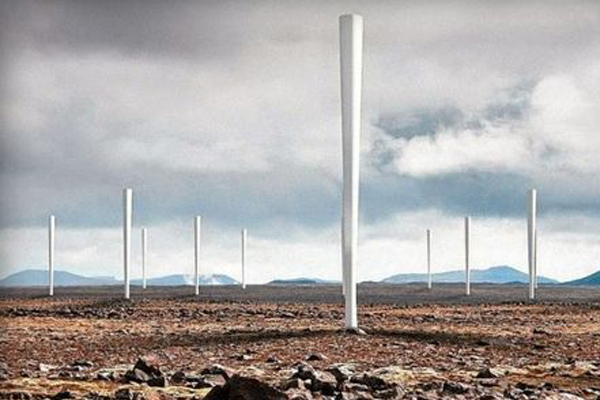By Bill Tucker, contributor at Forbes. Vortex Bladeless is a radical company. It wants to completely change the way we get energy from the wind. Think wind stick instead of a massive tower with blades that capture blowing winds.
Wind stick. Really. Lest you think I’m mad, I’ve included a picture of this bladeless generator that helps with the visualization and explains the company name.
See? There are no blades. What that “stick” (the company prefers, mast) does is capitalize on an effect of the wind which has been a very serious problem for architects and engineers for decades.
When wind hits a structure and flows over its surfaces the flow changes and generates a cyclical pattern of vortices at the tail end of the flow. This is known as the vortex shedding effect which creates something known as vorticity and that is what Vortex Bladeless uses to generate energy. For those who need a explanation that exceeds my ability to fully explain, check out this link from Columbia University on the subject and then come back and join the rest of us who won’t wait for you. (you’re clearly ahead of us anyway) If you are still here with me, the company likes to give a classic example of vorticity that is immediately understandable; the collapse of the Tacoma Narrows Bridge that came apart three months after it opened in 1940. This clip posted on YouTube from a film made as the bridge undulated, wavered and ultimately shows the very dramatic effect of vortex shedding. Powerful stuff. Engineers immediately changed the way they designed and built bridges as a result of this incident.
What the engineers at Vortex Bladeless are doing is embracing this effect instead of avoiding the aerodynamic instabilities to capitalize on the oscillation and therefore capture the energy. The mast is designed to oscillate in the wind (which is very different from Blowing in the Wind). As you can see in the picture above, this is not your usual wind turbine. It consists of a fixed mast, a power generator that has no moving parts which come into contact with each other and a semi-rigid fiberglass cylinder. The power generator is a system of magnetic coupling devices which means there are no gears needing lubrication and an overall system needing less maintenance.

According to David Suriol Puigvert, one of the company’s co-founders (there are 3), the costs of a Votex system are dramatically lower than traditional wind turbines. The company publically claims maintenance costs that are 80% below a traditional wind turbine with manufacturing costs that are 53% lower. The lower maintenance & manufacturing costs add up an estimated lower cost per kilowatt.
In addition to the lower carbon footprint of a wind turbine, Vortex claims even further reductions. Because there are no spinning blades, no birds are caught up and sent to their deaths in the name of greener energy. And the lack of blades means something else; much lower noise. Did you know there is a bi-annual conference for the purpose of resolving noise complaints from the large utility-scale turbines? I didn’t. Having driven by large wind farms in the mid-west I can say that I never noticed a problem yet it’s good to know a lot of attention is being given to the issue.
The fly in this very cool ointment is that the technology is a proven concept and is currently is being tested and fine tuned in the field. This means we are about a year away from the reality of Vortex generated electricity. Initially, the co-founders were looking at large generating devices. That remains a longer-term goal but a much shorter range goal is a device of 4kW Vortex that would be about 13 meters tall (40’) and weigh about 220lbs. The company sees this generator being used in conjunction with solar generation for homes that are either off the grid or want to be off the grid. They are also developing a 100W device that will stand about 3 meters (9’) tall weighing about 22lbs. It is named the Vortex Atlantis and the company believes it can be used in off-grid areas to bring power to third world/developing villages where power could be a matter of life and again, used with solar generation. Those devices are forecast to be on the market in roughly a year.A 1MW generator is currently forecast to be about 3 years from market.
Just a quick word about the company before wrapping up. Vortex is a Spanish tech start-up. Its funding, so far, has come from a Repsol Foundation Grant, a loan from the Spanish Government and venture capitalists in Spain (Spanish Angels). In February of this year, Vortex Bladeless relocated to Boston. Here it is working with Harvard University, SunEdison, IDEO and is working with venture capitalists for its next round of Series A funding. Due to public interest in investing in the company, they will launch a crowdfunding campaign on June 1. As always, look before you leap. This is very exciting technology but let your brain guide your investing not your excitement.

